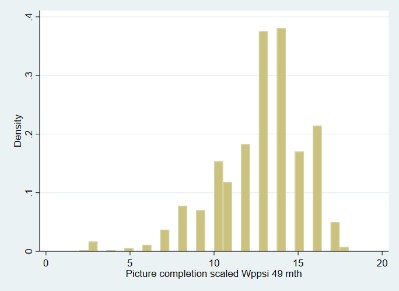The Avon Longitudinal Study of Parents and Children (ALSPAC) assessed their cohort members (CMs) at 49 months’ age (Children in Focus Clinic) using the Picture Completion measure from the Wechsler Preschool and Primary Scale of Intelligence Revised (WPPSI-RUK).
Details on this measure and the data collected from the CMs are outlined in the table below.
| Domain: | Non-verbal visualisation |
| Measures: | Simultaneous processing |
| Visual organisation | |
| Visual recognition | |
| CHC: | Gv (Visual processing) |
| Gc (Crystallised intelligence) | |
| Administration method: | Trained interviewer; clinical setting; child points to answer |
| Procedure: | The child was shown an image and then asked to point to or name the important missing part. For instance, a picture may have shown a person without an arm. Or, it might have shown a basketball game, complete with all the players, but with no ball. The child had 30 seconds to answer each item. Sample items (number differs with age) were provided to ensure the child understood the test. One point was awarded for each correct response within the time-limit. |
| Link to questionnaire: | http://www.bristol.ac.uk/alspac/researchers/our-data/clinical-measures/ (opens in new tab) |
| Scoring: | Standardised score (M = 10, SD = 3) |
| Item-level variable(s): | Not readily available |
| Total score/derived variable(s): | cf805 |
| Descriptives: | Raw score |
| N = 1,014 | |
| Range = 2 - 18 | |
| Mean = 12.73 | |
| SD = 2.65 | |
(click image to enlarge) |
|
| Age of participants: | Mean = 212.39 weeks, SD = 1.63, Range = 207 - 221 |
| Other sweep and/or cohort: | ALSPAC – Age 8.5 – WISC-III Picture Completion |
| Source: | Wechsler, D. (1989). Wechsler Preschool and Primary Scale of Intelligence-Revised. WPPSI-R. Psychological Corporation. |
| Technical resources: | Kaufman, A. S., & Lichtenberger, E. O. (2000). Essentials of WISC-III and WPPSI-R Assessment. John Wiley & Sons Inc. |
| Reference examples: | Bornstein, M. H., Hahn, C. S., Bell, C., Haynes, O. M., Slater, A., Golding, J., ... & ALSPAC Study Team. (2006). Stability in cognition across early childhood: A developmental cascade. Psychological Science, 17(2), 151-158. |
| Taylor, C. M., Kordas, K., Golding, J., & Emond, A. M. (2017). Data relating to prenatal lead exposure and child IQ at 4 and 8 years old in the Avon Longitudinal Study of Parents and Children. Neurotoxicology, 62, 224-230. |
For the named item in the table above, a link is provided to the corresponding CLOSER Discovery content.
Go to:
- Overview of all cognitive measures in ALSPAC
- Overview of childhood cognitive measures across all studies
This page is part of CLOSER’s ‘A guide to the cognitive measures in five British birth cohort studies’.
